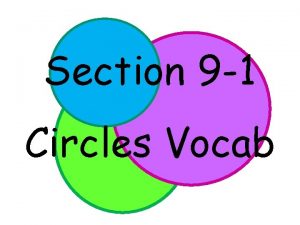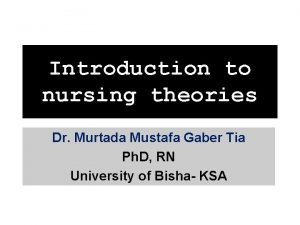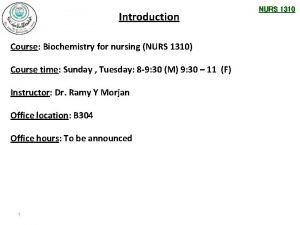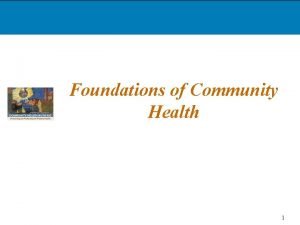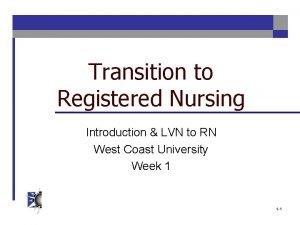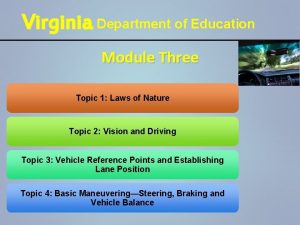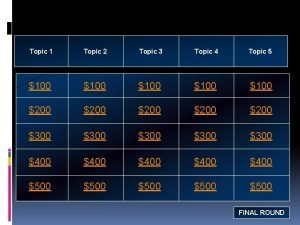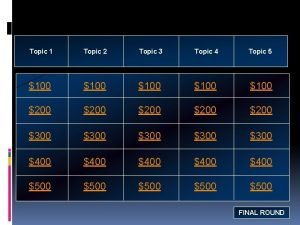Introduction to Nursing TOPIC 1 Introduction to Nursing





















- Slides: 21

Introduction to Nursing TOPIC 1: Introduction to Nursing Learning Goal C: Identify the systems of a healthy body HLT 33115 Unit: HLTAAP 001 - Recognise healthy body systems Related Assessment: Task C

Recap - https: //www. emaze. com/@AWWCWRWR/Untitled

Cardiovascular Systems Cardiovascular system – is responsible for transporting oxygen, nutrients, hormones, and cellular waster products throughout the body and maintaining pressure http: //www. innerbody. com/image/nervov. html

Cardiovascular Systems Organs: Heart, blood vessels (arteries and veins) Tissue: Connective tissue, muscular tissue, epithelial tissues, nervous tissue Cells: blood cells, smooth muscle tissue. http: //www. innerbody. com/image/nervov. html Molecules: Calcium for pumping of the heart.

Structure: Heart: muscular organ that Pumps blood around the body Arteries: Thick tubes that pump oxygenated blood around the body Capillaries: Blood vessels with thin Wall to allow exchange of gases, nutrients and waste between cells or tissues and blood. Veins: Large tubes which take Deoxygenated blood back to the body.

https: //fineartamerica. com/featured/gross-anatomy-of-the-human-heartstocktrek-images. html

Key Points: 1) The heart pumps blood around the body to provide 2) The heart has key structural components that allow it to pump blood around the body. 3) The key focus of the heart is to maintain blood pressure Nursing assessments: 1) Taking Blood Pressure

Key Points: 1) The heart pumps by electrical signals. which cause the smooth muscles to contract. 2) It is controlled by the autanomic nervous system through the brainstem and Vagus nerve These stimulate the SA node and AV node which intern make the smooth muscles contact. 3) a normal heart beat (sinus rhythm) at rest is roughly 6 o beats per minute. 4) We can listen to someones heart rate at the brachial artery, carotid artery or apex. Nursing assessments: 1) Taking Pulse

Key Points: 1) Blood is moved around the body through arteries, veins and capillaries. 2) Oxygen is transferred to different parts of the bodies tissues and carbon dioxide is removed. Nursing assessments: 1) Oxygen Saturation

- Heart - Pumps blood Right atrium - Deoxygenated blood enters heart Left Atrium – Oxygenated blood enters Right Ventricle – Pumps deoxygenated blood to lungs Left Ventricle – Pumps oxygenated blood to body Tricuspid Valve – separates right atrium and ventricle Pulmonary Valve – Separates right ventricle and pulmonay artery Mitral Valve – separates left atrium and right ventricle Aortic Valve – separates right ventricle and aorta Pericardium - covering the heart for protection and smooth movement Interventricular Septum - muscle that separates right/left heart Apex - bottom point of the heart. Sinoatrial Node - initial electrical signal for atrium contraction Atrioventricular Node - second electrical signal for ventricular contraction Superior Vena Cava – brings deoxygenated blood from arms and head to left atrium Inferior Vena Cava – brings deoxygenated blood from torso and legs to left atrium Aorta - takes blood from right ventricle to Pulmonary Artery - deoxygenated blood to the lungs Pulmonary Vein – oxygenated blood to the heart

Key Vessels: Head: Jugular Vein (internal and external) – take deoxygenated blood back from the head Carotid Artery (internal and external) - Take oxygenated blood to the head Facial artery and vein - takes blood to and from the face Arms Brachiocephalic artery and viens - Takes blood to and from the heart and the subclavian artery and veins in the arms Subclavian Artery and Veins (Left and Right) takes blood up and down the arms Brachial arteries and veins - Takes blood to and from the upper arm. Radial Artery - takes blood to the hand (thumb side) Ulnar Artery - takes blood to the hand (pinky side)

Key Vessels: Torso and Key Organs Common Hepatic Artery and Vein - Take blood to and from the liver Celiac Artery (Gut) - Takes blood to the gut Mesenteric Artery and Vein - takes blood to and from the intestines Renal Arteries and Veins takes blood to and from the kidneys Illiac arteries and veins - takes blood to and from pelvis area (i. e. bladder, and reproductive areas) Legs Femoral Arteries and Veins take blood to and from the legs and hip Fibular artery and veins Takes blood to and from the upper leg Great Saphenous Vein - take blood from the leg Popliteal Artery and Vein - takes blood to and from the knee and calf Tibial Arteries and Viens (anterior and posterior) - take blood to and from the lowe leg Metatarsal arteries and veins takes blood to and from the foot.

A healthy cardiovascular system therefore: 1) healthy oxygenation of all tissues of the body i. e. colour, warmth and saturation 2) Sufficient Cardiac output - the volume of blood flowing through any given vessel, or through the circulatory system as a whole, per minute: - Regular and strong pulse in sinus rhythm (roughly 60 beats per minute at rest) - Consistent blood pressure (roughly 120/80) (Systolic/Diastolic)

Nursing Assessments to assess the cardiovascular system and respiratory system: (i. e. Vital Signs) 1) 2) 3) 4) Respiratory Rate (Respiratory System) Saturation of oxygen (Respiratory and cardiovascular) Pulse (cardiovascular) Blood Pressure (cardiovascular)

When are they done? 1) 2) 3) 4) On new admission to gain baseline observation When a patient is transferred to or from a health facility Change in treatment or management patient; s whose condition has changed suddley In general

Pulse Oximitry (Oxygen Saturations) Pulse oximetry measures oxygen saturations in the patient’s blood. Altered oxygen saturations are a late sign of respiratory distress. Initially the body will try and compensate for hypoxia by increasing the rate and depth of respirations. By the time the oxygen saturations are decreasing the patient is usually very compromised. - Normal oxygen saturations are between 97 -100%. - Oxygen saturations < 90% correlate with very low blood oxygen levels and require urgent medical review. If your patient’s oxygen saturations are low you will usually notice other signs that the patient is short of breath such as increased respiratory rate and effort. - In general Clinical Emergency call must be made for oxygen saturations < 90% unless otherwise modified on the General Observation Chart

Pulse - The pulse should be measured by palpating the patient’s radial pulse. - If you are unable to access the patient’s radial pulse, other sites can be used as appropriate. - The patient’s radial pulse should be assessed for rate, rhythm and amplitude (strength). - The pulse should be counted for 30 seconds or longer (1 minute) if the rhythm is irregular. - The normal adult pulse rate is 60 – 100 bpm. - The pulse should be counted when the patient is at rest (at rest = no physical activity for 20 minutes). -The pulse rate is to be immediately charted on the General Observation Chart - A Clinical Emergency call is to be activated if the pulse rate is < 40 or > 130 bpm unless modified on the General Observation Chart.

Blood pressure Routine BP assessment is to be undertaken manually - Optimal adult BP should be < 130 mm. Hg Systolic and < 85 mm. Hg Diastolic. - The adult Systolic Blood Pressure (SBP) should be greater than 90 mm. Hg. If the SBP is < 90 mm. Hg the RPAH Clinical Emergency Response System should be activated unless modified on the General Observation Chart - If the SBP is > 200 mm. Hg the RPAH Clinical Emergency Response System should be activated unless modified on the General Observation Char - The normal adult pulse pressure (difference between the SBP and the Diastolic Blood Pressure (DBP)) is between 30 – 50 mm. Hg.

Blood pressure Performing a Manual Blood Pressure (BP) - The patient should be at rest (at rest = no physical activity for 20 minutes) & restrictive clothing removed from the arm. - Select the appropriate sized cuff. Ideally the width of the cuff should be 40% of the circumference of the midpoint of the limb on which the cuff is to be used. Cuffs that are too narrow for the size of the limb will result in a falsely elevated BP. Conversely, cuffs that are too large for the size of the limb will result in a falsely low BP measurement - The arm should be supported at the level of the heart - Check the systolic blood pressure (SBP) by inflating the cuff until the radial pulse can no longer be felt. Gradually deflate the cuff until you can feel the radial pulse. This point represents the SBP. This is also a very useful way to assess blood pressure in a sick hypotensive patient if you can’t auscultate the pressure with a stethoscope. - Place the diaphragm of the stethoscope over the brachial pulse (do not tuck under cuff) and inflate to 30 mm. Hg higher than the SBP. - Deflate the cuff at 2 -3 mm. Hg per heartbeat. - Korotkoff sounds are auscultated to determine SBP and DBP. - SBP is the highest point at which the initial tapping (Korotkoff phase 1) is heard in two consecutive beats during exhalation. - DBP is equated with the disappearance of Korotkoff sounds


So What? Summary Key Terms- these are taken from our discussions. Please note these are not exact definitions but provide a general understanding. Respiratory System: Responsible for: cellular respiration - for transporting oxygen, nutrients, hormones, and cellular waster products throughout the body and maintiaining pressure Organs: heart, arteries, veins, capillaries Tissue: Connective tissue, muscular tissue, epithelial tissues, nervous tissue Cells: blood cells, smooth muscle tissue. Key Terms Cardiac output: amount of blood being pumped around the body per minute Heart rate: Beats per minute Blood Pressure – amount of effort the heart needs to pump blood around the body: Systolic – most effort to pump blood Diastolic – least effort to pump blood Artery – blood away from heart Vein – blood to heart Capillary – diffusion of oxygen or carbon dioxide to tissues of the body Simple Diffusion – Movement of molecules (oxygen or carbon dioxide) across a cell membrane into a cell. Osmosis – movement of molecules via diffusion from most concentrated to least concentrated space. Oxygenation – To have oxygen Deoxygenated – To not have oxygen Key Structures: Heart - Pumps blood Right atrium - Deoxygenated blood enters heart Left Atrium – Oxygenated blood enters Right Ventricle – Pumps deoxygenated blood to lungs Left Ventricle – Pumps oxygenated blood to body Tricuspid Valve – separates right atrium and ventricle Pulmonary Valve – Separates right ventricle and pulmonay artery Mitral Valve – separates left atrium and right ventricle Aortic Valve – separates right ventricle and aorta Pericardium - covering the heart for protection and smooth movement Interventricular Septum - muscle that separates right/left heart Apex - bottom point of the heart. Sinoatrial Node - initial electrical signal for atrium contraction Atrioventricular Node - second electrical signal for ventricular contraction Superior Vena Cava – brings deoxygenated blood from arms and head to left atrium Inferior Vena Cava – brings deoxygenated blood from torso and legs to left atrium Aorta - takes blood from right ventricle to Pulmonary Artery - deoxygenated blood to the lungs Pulmonary Vein – oxygenated blood to the heart Jugular Vein (internal and external) – take deoxygenated blood back from the head Carotid Artery (internal and external) - Take oxygenated blood to the head Brachial arteries and veins - Takes blood to and from the upper arm. Radial Artery - takes blood to the hand (thumb side) Ulnar Artery - takes blood to the hand (pinky side) Femoral Artery – blood to the legs Healthy cardiovascular system: 1) healthy oxygenation of all tissues of the body i. e. colour, warmth and saturation 2) Sufficient Cardiac output - the volume of blood flowing through any given vessel, or through the circulatory system as a whole, per minute: Regular and strong pulse in sinus rhythm (roughly 60 beats per minute at rest) Consistent blood pressure (roughly 120/80) Nursing Observations: 1) Saturation of oxygen - saturation of blood in body with oxygen 2) Capillary Refil 3) Heart Rate (Pulse) – beats per minute 4) Blood Pressure – Systolic / Diastolic
 Concluding sentence
Concluding sentence Narrowed down topic
Narrowed down topic Circle vocab
Circle vocab Team nursing and modular nursing
Team nursing and modular nursing Nursing diagnosis of ocd according to nanda
Nursing diagnosis of ocd according to nanda Nursing diagnosis cataract nursing care plan
Nursing diagnosis cataract nursing care plan How to write a care plan
How to write a care plan Nursing process in psychiatric nursing
Nursing process in psychiatric nursing Supine position
Supine position Classification of nursing theories
Classification of nursing theories Introduction of biochemistry in nursing
Introduction of biochemistry in nursing Component of community health nursing
Component of community health nursing From 1900 to 1940, research in nursing focused on:
From 1900 to 1940, research in nursing focused on: Lpn vs rn
Lpn vs rn Bed making types
Bed making types What is a topic sentence
What is a topic sentence Topic sentence structure
Topic sentence structure Topic sentence example for essay
Topic sentence example for essay Example of explanatory paragraph
Example of explanatory paragraph Worlds school debate
Worlds school debate Easy topic about life
Easy topic about life Drivers ed module 3 topic 1
Drivers ed module 3 topic 1


